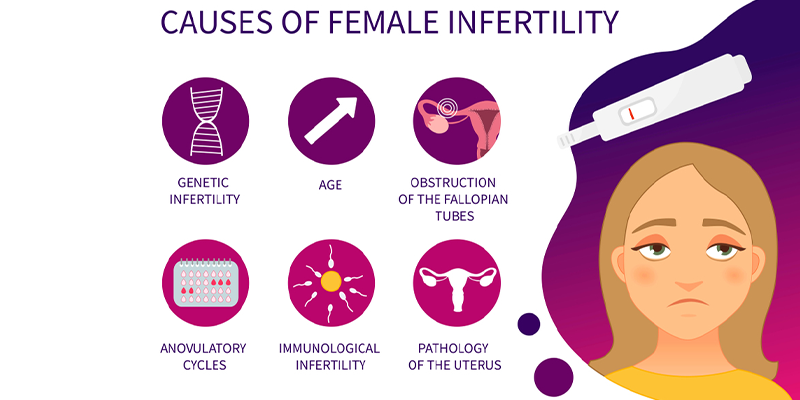Infertility

Infertility: Causes, Diagnosis, and Treatment Options
Infertility is defined as the inability to conceive after 12 months of regular, unprotected intercourse, or after six months for women over 35 years. It affects both men and women and can result from various medical, lifestyle, or unexplained factors. Below is a detailed overview of infertility, including its causes, diagnostic methods, and treatment options.
Causes of Infertility
1. Female Infertility:
Common causes include:
- Ovulatory disorders: Irregular or absent ovulation due to conditions like polycystic ovary syndrome (PCOS), thyroid dysfunction, or hypothalamic amenorrhea[4][5].
- Endometriosis: Growth of endometrial tissue outside the uterus causes inflammation and scarring, interfering with fertilization[1][2].
- Blocked fallopian tubes: Prevent sperm from reaching the egg; often caused by infections or pelvic adhesions[6][7].
- Uterine abnormalities: Polyps, fibroids, or congenital malformations can hinder implantation[6].
2. Male Infertility:
Key factors include:
- Low sperm count: Reduced number of sperm in semen[1][5].
- Poor sperm motility: Sperm unable to swim effectively toward the egg[1].
- Abnormal sperm morphology: Irregularly shaped sperm that may not function properly[1].
- Hormonal imbalances: Low testosterone or other endocrine disorders affecting sperm production[1][5].
- Structural issues: Blockages (e.g., varicoceles) or ejaculatory dysfunction[5][7].
3. Shared or Lifestyle Factors:
- Age: Fertility declines with age for both sexes[3][4].
- Smoking, alcohol, and drug use: Negatively impact reproductive health[3].
- Obesity or underweight: Hormonal imbalances linked to weight can affect fertility[3][4].
- Sexually transmitted infections (STIs): Can damage reproductive organs[3][6].
Diagnosis
Infertility evaluation involves tests for both partners:
1. For Women:
- Ovulation tests: Blood tests to measure hormone levels (e.g., FSH, LH, estradiol)[4][7].
- Imaging studies: Ultrasound or hysterosalpingography (HSG) to assess uterine abnormalities and tubal blockages[1][5].
- Laparoscopy: Minimally invasive procedure to detect endometriosis or pelvic adhesions[1][4].
2. For Men:
- Semen analysis: Evaluates sperm count, motility, and morphology[5][7].
- Hormonal tests: Measures testosterone and other hormones affecting sperm production[5].
- Imaging studies: Ultrasound to identify structural abnormalities like varicoceles[5][7].
Treatment Options
Treatment depends on the underlying cause:
1. Medical Treatments:
- Ovulation induction medications (e.g., clomiphene citrate, letrozole): Stimulate egg release in women with ovulatory disorders[4][8].
- Hormone therapy for men: Improves sperm production by correcting hormonal imbalances[5][8].
2. Surgical Interventions:
- For Women: Repair blocked fallopian tubes, remove uterine fibroids or polyps, and treat endometriosis through laparoscopy or hysteroscopy[2][5][6].
- For Men: Correct varicoceles or unblock ejaculatory ducts through surgery[5].
3. Assisted Reproductive Technology (ART):
ART involves handling eggs and sperm outside the body:
- Intrauterine insemination (IUI): Direct placement of healthy sperm into the uterus during ovulation[5][8].
- In vitro fertilization (IVF): Eggs are fertilized with sperm in a lab; embryos are then implanted into the uterus[5][8].
- Techniques like intracytoplasmic sperm injection (ICSI) may be used for severe male infertility cases.
4. Lifestyle Modifications:
Improving diet, exercise habits, and avoiding harmful substances can enhance fertility outcomes for both partners[3].
Conclusion
Infertility is a complex condition requiring a tailored approach based on its underlying causes. Advances in diagnostic tools and treatments like ART provide hope for couples struggling to conceive. Early evaluation and intervention are crucial for improving success rates.
Consult with Our Team of Experts Now!
At DrStemCellsThailand (DRSCT)‘s Anti-Aging and Regenerative Medicine Center of Thailand, we emphasize comprehensive evaluations and personalized treatment plans of Cellular Therapy and Stem Cells for managing various health conditions. If you have questions about Oncolytic Virus Therapy (OVT) or would like more information on our services, consult with our experts today!
Consult with Our Team of Experts Now!
References:
- Title: Effects of lifestyle factors on fertility: practical recommendations for improving reproductive outcomes
DOI: 10.1016/j.rbmo.2021.01.008
Summary: This study reviews the impact of modifiable lifestyle factors, such as diet, smoking, alcohol consumption, and stress, on fertility in men and women, offering practical recommendations to enhance reproductive outcomes. - Title: Role of Assisted Reproductive Technology in Infertility Treatment
DOI: 10.1093/humrep/deab123
Summary: Explores the advancements in assisted reproductive technologies (ART), including IVF and ICSI, and their role in overcoming infertility challenges. - Title: Laparoscopy for Infertility Diagnosis: Benefits and Limitations
DOI: 10.1016/j.fertnstert.2020.09.045
Summary: Discusses the use of laparoscopy as a diagnostic tool for infertility, highlighting its ability to identify conditions like endometriosis and tubal adhesions with high accuracy.















